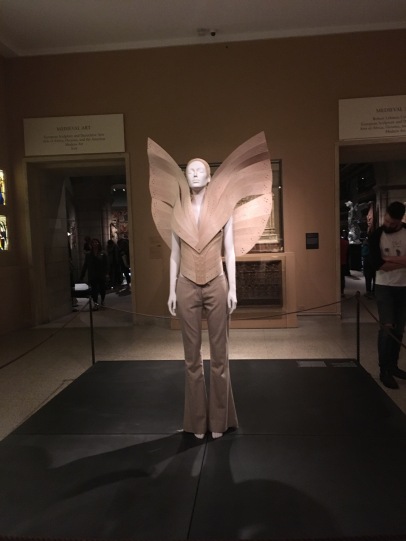
Leo Saul Berk: Wind Jangle, 2015
Aluminum, fishing line, weights; courtesy of Leo Saul Berk
There’s a house west of architecture-rich Chicago, in Aurora, that was scorned by other residents when it was built back around the middle of the last century: the so-called Ford House, designed for Albert and Ruth Van Sickle Ford by the maverick architect, painter, and composer Bruce Goff. With its dramatic geometrical accents and manipulation of light and space, along with its use of recycled World War II materials like Quonset huts, Ford House is a testament to the idiosyncratic, visionary imagination of the Kansas-born Goff.
Ford House also happens to be the dwelling in which the Seattle-based artist Leo Saul Berk spent part of his childhood. Structure and Ornament, Berk’s first major solo museum show, distills his memories of the wondrously unconventional environment in which he grew up. The resulting works, now on view at the Frye Museum, take the form of sculpture, video, and photography, along with two site-specific installations.

Leo Saul Berk: Clinkers, 2012. Duratrans, sculptural light box. 76 x 64 5/8 x 3 3/4 in. Frye Art Museum, 2013.002.
Some of Berk’s pieces involve fanciful recreations of particular details from Ford House: “recreations” in the sense of attempts to recapture the visual poetry, say, of the setting sun as perceived through the semitransparent glass cullet windows positioned in Goff’s walls of coal masonry, which cause it to cast a green glow. (Berk’s backlit true-to-scale photograph is titled Clinkers.)
Other pieces are more tangentially related riffs on the impressions the house made on Berk growing up — impressions he’s been contemplating again over the last few years. This reengagement with Ford House led Berk to strike up a friendship with its current owner, the architectural historian Sidney K. Robinson. “Going back” to it both physically and in emotional terms has intensified Berk’s curiosity about the enduring impact his former home left on his artistic development.
My favorite among the loosely related fantasies is a video piece inspired by Berk’s visit to re-explore these roots. He was initially grossed out by a film of calcium deposits lining the bathtub, but when he filled it with water and then pulled the plug, a dancing cosmos of starlike detritus emerged, spotlit by the skylight directly overhead, before vanishing down the drain’s black hole.
Less effective is a sculpture in which Berk uses modern technology to try to “update” Goff’s vision, creating a miniature model of the central dome that had been the architect’s original plan. (The original specs proved too complex to execute.)
One piece, Berk’s homage to Goff’s organizing concept of a birdcage dome, gives the exhibit its title: the plywood-and-acrylic Structure and Ornament is both spikily abstract and mesmerizingly quirky — and in fact remarkably fragile, says Berk, for all its defiant severity.

Leo Saul Berk: Structure and Ornament (installation view), 2014. Plywood and Acrylic. 120 x 213 x 59 in. Courtesy of the artist. Photo: Mark Woods
And the concept of structure and ornament — construed by some modernists as at odds or even incompatible — feeds into larger concerns, according to Frye director Jo-Anne Birnie Dansker.
Berk’s responses to Ford House, she writes, “propose a modernity that honors visionary, utopian dreams of the past in which light, color, structure, material, ornament, poetry, and music could ignite a spiritual force that would unify the arts in harmony with nature and transform individuals and the social and cultural life of a nation.”
Structure and Ornament continues at the Frye Museum until 6 September, along with a series of exhibits on Andy Warhol and ideas of portraiture. Admission is free.
(c) 2015 Thomas May. All rights reserved.
Filed under: architecture, art exhibition, Frye Museum, preview





 Yayoi Kusama’s Infinity Mirrors
Yayoi Kusama’s Infinity Mirrors





